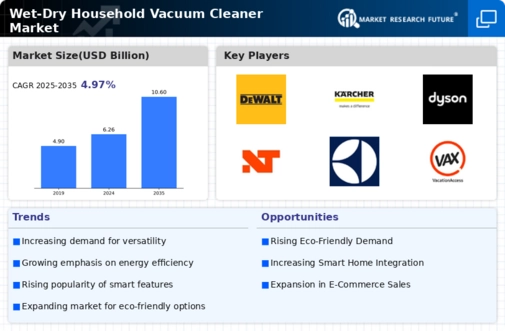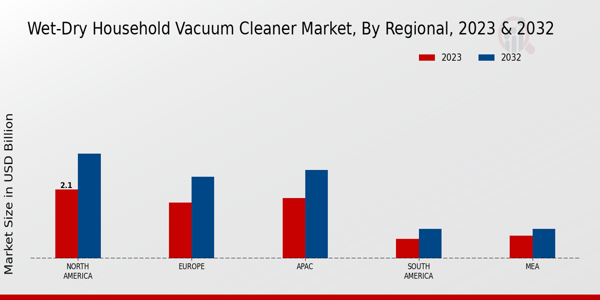Market Growth Projections
The Global Wet-Dry Household Vacuum Cleaner Market Industry is projected to experience substantial growth over the next decade. With a market value expected to reach 6.26 USD Billion in 2024 and 10.6 USD Billion by 2035, the industry is on a promising trajectory. The anticipated CAGR of 4.94% from 2025 to 2035 suggests a sustained increase in consumer demand and innovation within the sector. This growth is indicative of evolving consumer preferences and the ongoing development of advanced cleaning technologies, positioning the market for continued expansion.
Environmental Sustainability Trends
The Global Wet-Dry Household Vacuum Cleaner Market Industry is increasingly shaped by environmental sustainability trends. Consumers are becoming more environmentally conscious, seeking products that minimize ecological impact. Manufacturers are responding by developing vacuum cleaners that utilize sustainable materials and energy-efficient technologies. This shift not only aligns with consumer values but also addresses regulatory pressures for greener products. As sustainability becomes a key purchasing criterion, the market is likely to see a rise in demand for eco-friendly wet-dry vacuum cleaners, further driving growth in the coming years.
Increasing Awareness of Home Hygiene
The Global Wet-Dry Household Vacuum Cleaner Market Industry is significantly influenced by the increasing awareness of home hygiene. Consumers are becoming more conscious of the importance of maintaining clean living environments, particularly in light of health considerations. This heightened awareness drives the demand for effective cleaning solutions capable of tackling various messes. As a result, wet-dry vacuum cleaners are gaining popularity due to their efficiency in managing both liquid spills and dry debris. This trend is expected to sustain the market's growth, with a projected CAGR of 4.94% from 2025 to 2035, reflecting a long-term commitment to home cleanliness.
Rising Demand for Versatile Cleaning Solutions
The Global Wet-Dry Household Vacuum Cleaner Market Industry experiences a surge in demand for versatile cleaning solutions. Consumers increasingly prefer appliances that can handle both wet and dry messes, reflecting a shift towards multifunctional products. This trend is particularly evident in urban households where space is limited, and efficiency is paramount. The market is projected to reach 6.26 USD Billion in 2024, indicating a robust growth trajectory. As consumers seek convenience and effectiveness, manufacturers are innovating to meet these needs, potentially enhancing their market share in the competitive landscape.
Growth of E-commerce and Online Retail Channels
The Global Wet-Dry Household Vacuum Cleaner Market Industry benefits from the growth of e-commerce and online retail channels. The convenience of online shopping allows consumers to easily compare products, read reviews, and access a wider range of options. This shift in purchasing behavior is particularly relevant in the context of household appliances, where consumers seek informed choices. As e-commerce continues to expand, it is likely to facilitate increased sales of wet-dry vacuum cleaners, contributing to the market's anticipated growth. The accessibility of these products online may also enhance brand visibility and consumer engagement.
Technological Advancements in Vacuum Cleaner Design
Technological advancements play a pivotal role in shaping the Global Wet-Dry Household Vacuum Cleaner Market Industry. Innovations such as improved suction power, energy efficiency, and smart connectivity features are becoming increasingly prevalent. For instance, the integration of IoT technology allows users to control their vacuum cleaners remotely, enhancing user experience. As these technologies evolve, they are likely to attract a broader consumer base, contributing to the market's projected growth to 10.6 USD Billion by 2035. This evolution not only meets consumer expectations but also positions manufacturers favorably in a rapidly changing market.


























